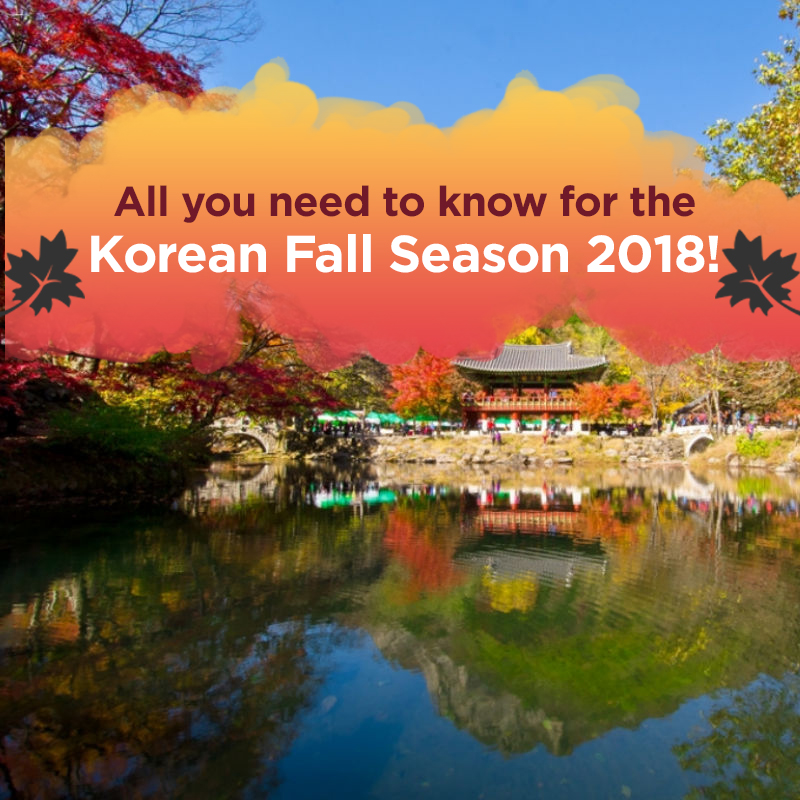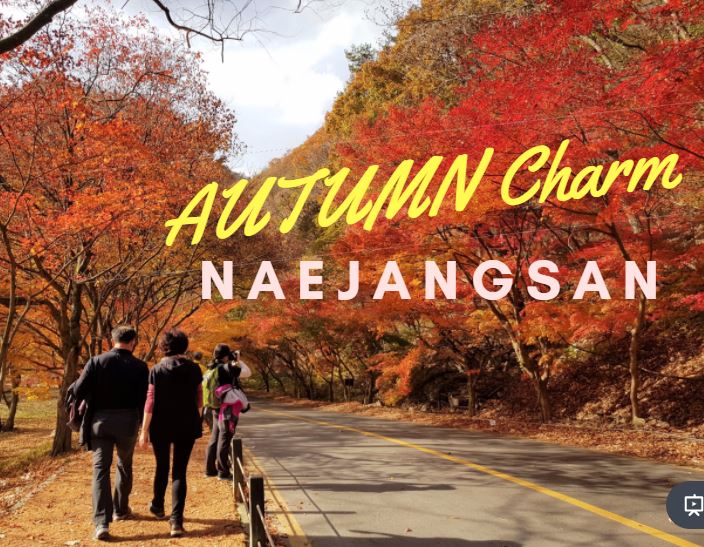
Korean Fall Season 2018 – All you need to know about Korea Fall Foliage!
KOREAN FALL FOLIAGE GUIDE 2018!
Autumn is a beautiful season to come visit Korea. Because of all the mountains and nature surrounding there are plenty of colorful foliage views! The weather is usually quite pleasant and there are even specific fruits and foods Korean eat during Autumn! Check out all the details in this blog post!
📍When is it?
The Autumn season in Korea falls in September, October, and November. See the best days to visit in our Fall Forecast pic below:

| Mountain | Start Date | Peak |
| Seoraksan National Park (NaeSeorak) | September 27 | October 18 |
| Odaesan National Park | October 2 | October 17 |
| Chiaksan National Park | October 8 | October 23 |
| Jirisan National Park (Nogodan Peak) | October 12 | October 26 |
| Woraksan National Park | October 12 | October 25 |
| Bukhansan National Park (Dobong) | October 15 | October 29 |
| Hallasan National Park | October 19 | November 1 |
| Palgongsan Natural Park (Gatbawi District) | October 19 | October 30 |
| Gyeryongsan National Park | October 19 | October 29 |
| Naejangsan National Park | October 21 | November 9 |
| Mudeungsan National Park | October 24 | November 7 |
* Forecasted dates above are subject to change depending on weather conditions.
🌂 How is the Weather like?
Actually, the weather is very pleasant! Especially in the month of October, in which the maximum temperatures get to around 20~22 Celsius. However, it can get very windy and chilly during the evenings/early mornings so a light jacket, nice hoodie or dress in multiple layers will do you good! Thicker jacket if you visit in November.
- September – Average temp 20°C (68°F)
- October – Average temp 13°C (55°F)
- November – Average temp 5°C (41°F)
TIP: Check the weather forecast regularly by checking the Korean search engine Naver
🍁Best places to go see the Fall Foliage in Seoul!
 |
 |
Left: Hanuel Park. Right: Deoksugung Palace
Capture the very best autumn views in Seoul! We recommend taking this Best Fall Foliage 1-day Private car tour to see and enjoy all these places:
- Seoul Palace (Gyeongbokgung)
- Deoksugung Palace
- Bugak Skyway Palgakjeong Pavilion
- Yeouido Hangang Park
- Seoul Worldcup Park (Haneul Park)
- Namsan Park and N Seoul Tower!
 KoreaTravelEasy
KoreaTravelEasy If you are looking for a nice private driver tour that takes you to other places than Seoul please click the link below and browse around here to find the most suitable tour for you!
🍁15 Top Places To See Autumn Leaves and Fall Foliage in Korea (Click to see the best tour)
We have compiled a top 15 list of the most popular places to visit in Korea during the Autumn. To see details of each place in a list please see this blog post: 15 Top Places to See Autumn Leaves and Fall Foliage in Korea
1. Naejangsan Mountain
2. Seoraksan Mountain
3. Daedunsan
4. Namsan Tower – Seoul
5. The Palaces Autumn Breeze – Seoul
6. Seoul Olympic Park
7. Gwanaksan Mountain
8. Seoul Grand Park
9. Bukhansan National Park
10. Gayasan Mountain
11. Jirisan National Park
12. Nami Island Autumn Walk
13. Garden of Morning Calm
14. Odaesan National Park Mountain
15. Namhansanseong Provincial Park
🍲The food you MUST try during Fall?
Foods are best in terms of taste and nutritional value when they are eaten in season. See what’s in for this fall!
Blue crab (꽃게): Delicious, nutritious, and reasonably priced!
Blue crabs are in season during spring and autumn. Crabs are prepared in a variety of ways and eat it in any form it will be delicious! A great recommended Korean dish would have to be gejang,: raw crab marinated in soy sauce or Yangnyeom-gejang which is made with red chili-pepper paste sauce.

Left: Ganjang-gejang Right: Yangnyeom-gejang
Photo from: visitkorea.or.kr
Jumbo Prawns (대하): A feast for the eyes & palate
Jumbo prawns are a mouthwatering fall specialty even to those who do not generally eat seafood. Those caught at sea are not easy to find outside local fishing areas, as these short-tempered crustaceans die quickly after they’re caught. Compared to farmed prawns, jumbo prawns caught at sea have longer antennas, thicker shells, and chewier meat.

Photo from: visitkorea.or.kr
Gizzard Shad (전어): Soft flesh and bold flavors
In the fall, gizzard shads store up plenty of nutrients for the long, cold winter; meaning they are packed with healthy oils and plenty of flavors. The best time to eat these is between late September to mid-November. Larger gizzard shads are higher in fat, so make sure to pick a fish over 15cm to enjoy the fish’s true taste.

Left: Gizzard shad sashimi Right: Grilled gizzard shad
Photo from: visitkorea.or.kr
Pine mushrooms (송이버섯): Small in size, big in flavor
Pine mushrooms only thrive on live pine trees and are harvested in autumn. Pine mushrooms are referred to as diamonds in the forest for their high nutritional value and efficacy. The mushroom is great for preventing geriatric diseases and protecting the stomach. More than anything, it is known for its cancer prevention qualities.

Photo from: visitkorea.or.kr
Persimmon (감): A sweet and healthy dessert!
Persimmon is a major autumn fruit in Korea. Depending on the level of processing, it is called by different names:
Hongsi refers to persimmon ripe to a color of yellow-orange or dark red-orange with no astringent taste.
Gotgam is persimmon peeled and dried under the sun and the wind.
Bansi is seedless persimmons.
Persimmon is high in vitamins A, B, and C, and minerals. The fruit is good for your skin and for getting over a hangover. The fruit is also highly effective for stopping diarrhea-related symptoms.
Fun fact: Hongsi can be frozen and eaten in shaved form or like an ice-cream. It is also enjoyed as a jam or in a salad.

Photo from: visitkorea.or.kr
🗻Planning to go to Naejangsan Mountain?
Naejangsan Mountain is considered to be the most beautiful place to be in Korea during Autumn, we can let the pictures speak for themselves. Read details about Naejangsan and watch a travel vlog in this blog post below:
 KoreaTravelEasy
KoreaTravelEasy 




